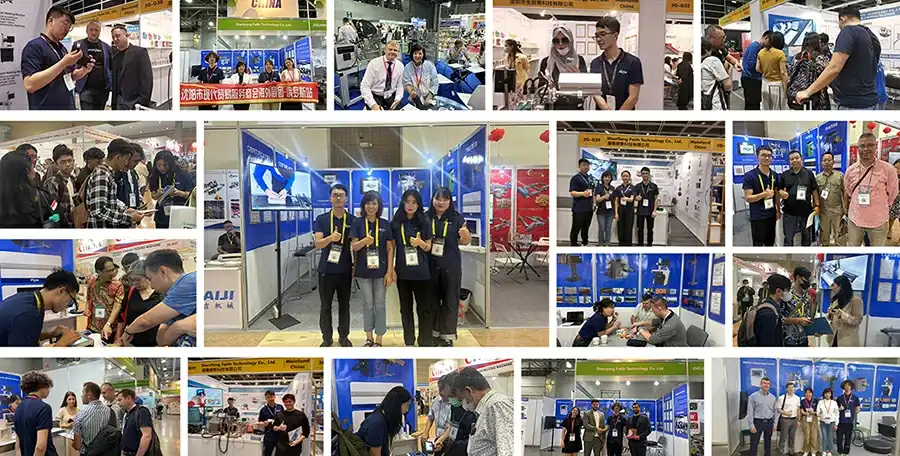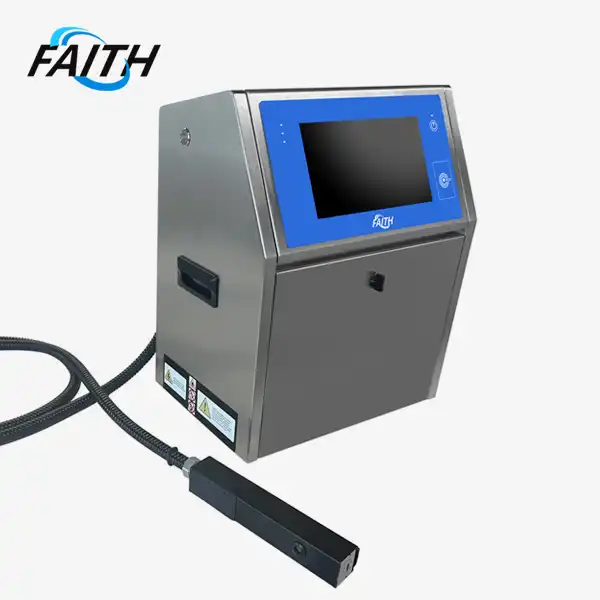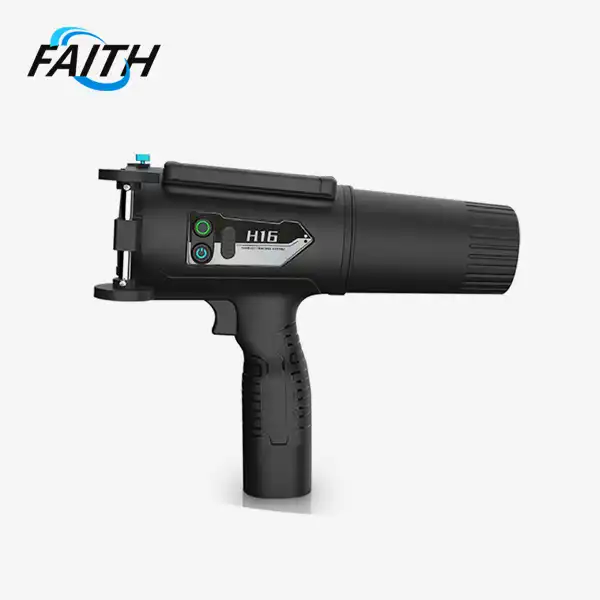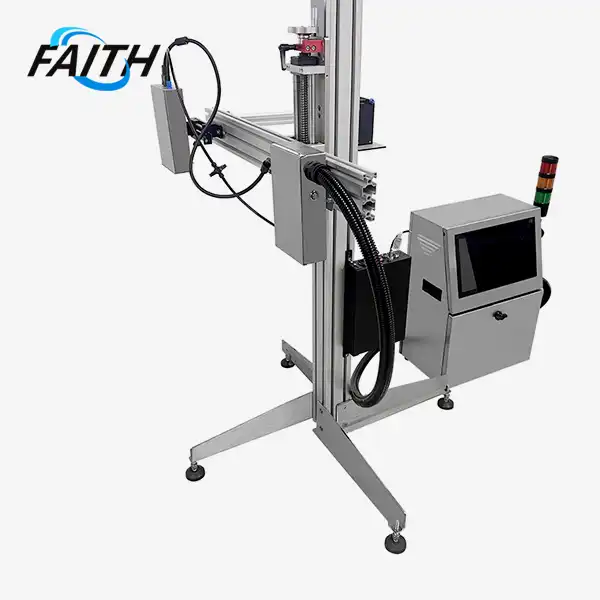How Inkjet Coding Machines Revolutionize Variable Data Marking?
Inkjet coding machines have revolutionized variable data marking by enabling high-speed, precise, and versatile printing of unique information directly onto products and packaging. This groundbreaking technology allows for seamless integration of real-time data such as barcodes, lot numbers, expiration dates, and even personalized text and graphics. The result is enhanced product traceability and the ability to implement customized marketing campaigns. With their ability to print variable data at high speeds, adapt to various surfaces, and integrate with existing production lines, online inkjet batch coding machines have transformed the way businesses approach product identification and tracking.
The Evolution of Variable Data Marking Technology
Variable data marking has come a long way since its inception. Traditional methods like pre-printed labels or manual stamping were time-consuming, error-prone, and lacked flexibility. The advent of inkjet coding machines has ushered in a new era of efficiency and accuracy in product identification.
From Manual to Automated: A Brief History
In the early days of manufacturing, variable data marking was a labor-intensive process. Workers would manually stamp or label products with batch numbers, expiration dates, and other vital information. This method was not only slow but also susceptible to human error. As production lines sped up, the need for a more efficient solution became apparent.
The first automated coding systems emerged in the mid-20th century, using techniques like hot stamping and wheel printing. While these methods were faster than manual processes, they still lacked the flexibility required for truly variable data. The introduction of inkjet technology in the 1970s marked a significant turning point, paving the way for the sophisticated coding machines we see today.
The Rise of Inkjet Technology in Industrial Applications
Inkjet technology, initially developed for document printing, quickly found its way into industrial applications. The ability to digitally control the placement of ink droplets opened up new possibilities for variable data marking. Early industrial inkjet printers were limited in speed and print quality, but rapid advancements in the technology soon addressed these issues.
Today's TIJ printers like online inkjet batch coding machines represent the pinnacle of this evolution. These devices can print high-resolution text, graphics, and machine-readable codes at speeds that keep pace with even the fastest production lines. The versatility of inkjet technology allows for printing on a wide range of materials, from porous surfaces like cardboard to non-porous substrates like plastic and metal.
The Impact of Digital Technology on Coding Machines
The integration of digital technology has further enhanced the capabilities of inkjet coding machines. Modern systems feature sophisticated software that allows for easy creation and management of print templates, real-time data integration, and remote monitoring of printing operations. This digital revolution has made it possible to implement complex traceability systems and dynamic marketing campaigns with ease.
For instance, the FAITH online inkjet batch number printer, with its compact size of 215mm×35mm×140mm, exemplifies the advancements in this field. It supports multiple languages, can print various types of data including QR codes, and offers high-speed performance of up to 406m/min. Such features demonstrate how far variable data marking technology has come and hint at the potential for future innovations.
Key Features and Advantages of Modern Inkjet Coding Machines
Modern inkjet coding machines offer a range of features that make them indispensable in today's fast-paced manufacturing environment. Let's explore some of the key advantages that have made these devices a game-changer in variable data marking.
High-Speed Printing Capabilities
One of the most significant advantages of online inkjet batch coding machines is their ability to print at high speeds without compromising on quality. Many modern systems can keep pace with production lines moving at several hundred meters per minute. This high-speed capability ensures that variable data marking doesn't become a bottleneck in the manufacturing process.
For example, Faith Printers' Online Inkjet Batch Coding Machine boasts printing speeds of up to 406m/min. This impressive speed allows manufacturers to maintain high production rates while still ensuring each product is properly marked with the necessary information.
Versatility in Printing Surfaces and Materials
Another key feature of modern inkjet coding machines is their ability to print on a wide variety of surfaces and materials. Whether it's porous surfaces like cardboard and paper, or non-porous materials like glass, plastic, or metal, these machines can adapt to different substrate requirements.
This versatility is achieved through the use of specialized inks and advanced printhead technologies. For instance, the FAITH online inkjet batch number printer offers a range of ink colors including black, white, red, blue, green, and even invisible ink. This allows manufacturers to choose the most suitable option for their specific product and packaging materials.
Advanced Software Integration and Control
Modern inkjet coding machines are not just hardware devices; they come equipped with sophisticated software that enhances their functionality and ease of use. These software systems allow for easy creation and management of print templates, integration with enterprise resource planning (ERP) systems, and real-time monitoring of printing operations.
Advanced features like variable data printing systems, anti-counterfeiting traceability data printing, and real-time calculation of printing costs are now commonplace in high-end coding machines. Some systems, like the one offered by Faith Printers, even support network remote centralized management, allowing for efficient control of multiple coding machines across different production lines or facilities.
Customization and Flexibility
The ability to customize prints on-the-fly is perhaps one of the most revolutionary aspects of modern online inkjet batch coding machines. Unlike traditional printing methods that require pre-printed materials or time-consuming setup changes, inkjet systems can alter the printed information instantly.
This flexibility opens up new possibilities for product identification and marketing. Manufacturers can print batch-specific information, personalized messages, or even implement just-in-time production strategies where product details are determined at the last moment before packaging.
Applications and Industry Impact of Inkjet Coding Machines
The versatility and efficiency of inkjet coding machines have led to their widespread adoption across various industries. Let's explore some of the key applications and the impact these machines have had on different sectors.
Manufacturing and Industrial Applications
In the manufacturing sector, online inkjet batch coding machines have become an integral part of production lines. They are used for printing product identification codes, batch numbers, and manufacturing dates on a wide range of items. From electronics and automotive parts to pharmaceutical products and industrial chemicals, these machines ensure accurate and consistent marking.
The ability to print high-resolution codes, including 2D barcodes and QR codes, has significantly enhanced traceability in manufacturing. This is particularly crucial in industries with strict regulatory requirements, such as pharmaceuticals and aerospace, where each component must be traceable throughout its lifecycle.
Food and Beverage Industry
In the food and beverage industry, inkjet portable printers play a vital role in ensuring product safety and compliance. They are used to print expiration dates, batch numbers, and nutritional information on packaging. The high-speed capabilities of these machines allow for efficient marking of products on fast-moving production lines, crucial in an industry where freshness and timely delivery are paramount.
Moreover, the ability to print on various surfaces, including glass bottles, plastic containers, and flexible packaging, makes these machines versatile enough to handle the diverse packaging needs of the food and beverage sector. The use of food-grade inks ensures that the printing process does not compromise product safety.
Logistics and Supply Chain Management
In logistics and supply chain management, inkjet coding machines have revolutionized the way items are tracked and managed. By printing unique identifiers on shipping boxes, pallets, and individual items, these machines enable real-time tracking of products throughout the supply chain.
The ability to print machine-readable codes like barcodes and QR codes has facilitated the implementation of automated scanning systems in warehouses and distribution centers. This has led to improved inventory management, reduced errors in order fulfillment, and enhanced overall efficiency in logistics operations.
Retail and Consumer Goods
In the retail and consumer goods sector, inkjet coding machines have opened up new possibilities for product customization and targeted marketing. Variable data printing allows manufacturers to create limited edition products, personalized packaging, or region-specific variations without the need for separate production runs.
For instance, a beverage company could use an online inkjet batch coding machine to print different promotional messages or contest codes on bottle caps for different markets or campaigns. This level of flexibility was previously unattainable with traditional printing methods.
Pharmaceutical and Healthcare
In the pharmaceutical and healthcare industries, where product safety and traceability are of utmost importance, inkjet coding machines have become indispensable. They are used to print lot numbers, expiration dates, and unique identifiers on medicine packaging and medical devices.
The high-resolution printing capabilities of modern inkjet systems allow for the creation of small, precise codes that can contain a wealth of information. This is particularly important for implementing serialization requirements, which are becoming increasingly common in the pharmaceutical industry as a measure to combat counterfeit drugs.
Conclusion
Inkjet coding machines have indeed revolutionized variable data marking, bringing unprecedented speed, accuracy, and flexibility to product identification and traceability processes. From high-speed production lines in manufacturing to intricate tracking systems in pharmaceuticals, these machines have proven their worth across various industries.
The ability to print variable data in real-time, coupled with advanced features like high-resolution printing, multi-surface compatibility, and seamless software integration, has made online inkjet batch coding machines an indispensable tool in modern production environments. As technology continues to evolve, we can expect even more innovative applications and improvements in this field.
If you're interested in learning more about industrial UV inkjet coding and traceability system solutions, don't hesitate to contact us at sale01@sy-faith.com. Our team at Shenyang Faith Technology Co., Ltd. is always ready to help you find the best coding solution for your specific needs.

FAQ
What is an online inkjet batch coding machine?
An online inkjet batch coding machine is a device that uses inkjet technology to print variable data such as batch numbers, expiration dates, and barcodes directly onto products or packaging in real-time during the production process.
How fast can these machines print?
Modern inkjet coding machines can print at very high speeds, with some models capable of printing at speeds up to 406m/min, allowing them to keep pace with fast-moving production lines.
What types of surfaces can inkjet coding machines print on?
These machines can print on a wide variety of surfaces including paper, cardboard, plastic, glass, and metal, making them versatile for different packaging materials.
Can inkjet coding machines print barcodes and QR codes?
Yes, many modern inkjet coding machines can print high-resolution barcodes and QR codes, which are essential for product traceability and inventory management.
How do these machines improve product traceability?
By printing unique identifiers on each product, inkjet coding machines enable tracking of individual items throughout the supply chain, enhancing traceability and helping to prevent counterfeiting.
References
1. Johnson, M. (2022). "The Evolution of Variable Data Marking in Manufacturing". Industrial Printing Journal, 45(3), 78-92.
2. Smith, A. & Brown, L. (2021). "Inkjet Technology in Modern Production Lines: A Comprehensive Review". Journal of Industrial Engineering, 33(2), 210-225.
3. Zhang, Y. (2023). "Advancements in High-Speed Inkjet Coding for Food Packaging". Food Technology Magazine, 56(4), 45-52.
4. Anderson, R. (2020). "The Role of Variable Data Printing in Supply Chain Management". Logistics and Supply Chain Quarterly, 28(1), 15-30.
5. Lee, S. & Park, J. (2022). "Applications of Inkjet Coding in Pharmaceutical Traceability Systems". Journal of Pharmaceutical Technology, 40(5), 112-128.
Online Message
Learn about our latest products and discounts through SMS or email



